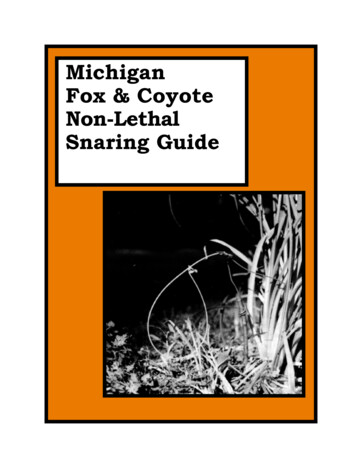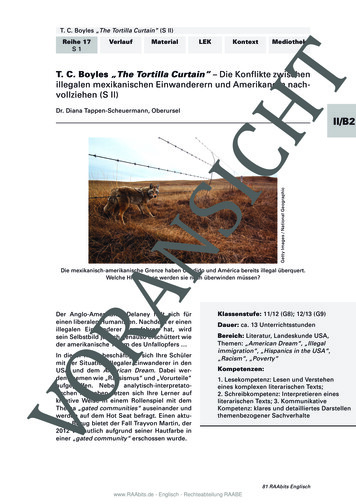
Transcription
MichiganFox & CoyoteNon-LethalSnaring Guide
Table of ContentsSnares Past & Present. . page 1The Modern Cable Snare . . .page 2Michigan Snaring Regulations . . page 7How A Snare Works . page 11Fastening and Stabilizing Snares . . page 12Non-lethal Snaring . . page 16Setting Snares . . . . . . . . . page 19Avoiding Deer and Livestock . . page 21Sets with Snares . . page 23Snares Past & PresentWhen you mention snares or snaring tomost people, they think of a bent over polewith a noose fastened to the end of it. Theyimagine an animal sticks its head throughthe noose, the pole springs free, and theanimal is jerked off its feet and hung. Thefact is that in days-gone-by, this is howsnaring was practiced, and this is the imagethat remains with many people today.Obviously, a snare like this would belethal to any animal that got in it. However,there are a couple of reasons why ourforefathers constructed and used snares inthis manner. First, the only thing availablefor making snares was cord or fine wire.Neither of these materials is exceptionallystrong and an animal could easily bite thesnare in two or break it. Also, they had nomeans for holding the noose closed to keepit cinched around the animal. For thesereasons, they employed the spring pole. Thepole pulled the noose closed, and ultimatelydispatched the animal so it could not breakthe snare and escape.Although this outdated misconception ofsnaring still exists, modern snares andmodern snaring methods are significantlydifferent from those of the past. Modernsnares are made of stranded steel cable. Thiscable is extremely strong and resistant toabuse, yet it is flexible enough to form easilyinto a loop. An animal can’t easily break thiscable or bite it in two. The modern cable snarealso has a locking device to keep the loopfrom opening back up once it starts to close.With these two features, it is no longernecessary to use a powering device to keepa snare closed, and animals can be heldalive because the cable can withstand theirefforts to escape. This gives the potentialfor the modern cable snare to be used as anon-lethal trapping device.Because old-fashioned snares onlyfunctioned in a lethal manner, snaring wasbanned in Michigan. But with the moderncable snare and its potential for holdinganimals alive and unharmed, the snare hasbeen reinstituted as a legal device forMichigan’s trappers taking fox and coyote.This guide has been prepared to helpfamiliarize you with the modern cablesnare. It is designed to give you the basicknowledge you need to use snares safelyand efficiently to take fox and coyote.When most people think ofsnaring, this is what theyvisualize. This may be howsnaring was practiced in daysgone-by, but today’s moderncable snares are not used in thismanner.12/05 Michigan Non-Lethal Snaring Guide - 1
The Modern Cable SnareThe modern cable snare is made ofstranded steel cable. This cable comes in twobasic configurations known as 7 x 7 and 7 x19. The 7 x 7 cable consists of 7 strands ofsmall diameter wire wound into a largerstrand. Then, 7 of these larger strands arewound together to make the finished cable.The 7 x 19 cable uses 19 very small wireswound into a strand with 7 of these strandsmaking up the cable. Michigan regulationsspecify that snares shall be made of 1 / 16inch or larger cable.This cable comes in several different sizesthat designate the diameter of the cable.Cable measuring 3/32 of an inch in diameteris the most popular size for snaring.Another integral part of the modern cablesnare is a sliding mechanical snare lock. Asthe snare loop is pulled closed, the lock slidesdown the cable. Although it may loosenslightly, the lock will not slide easily in theopposite direction. This is what keeps theanimal from backing out of the snare orshaking the snare off.Locks come in a wide variety of shapes,forms, and configurations. Michigan lawrequires a relaxing lock which is defined asa lock that allows the snare loop to loosenslightly when an animal stops pulling againstit. This is to reduce the possibility ofstrangulation. Locks that use springs or otherpowering devices to hold them closed are notlegal for use in Michigan. M o d e r n c a b l esnares also have some device on the end ofthe snare for fastening it in place. Thesimplest form of this is a loop fashioned inthe end of the cable. However, most snaresutilize a swivel as an end fastening device.Anchor swivels are required in Michiganbecause they allow the animal some freedomof movement while it is detained in the snare.Two swivels are required, one of which mustbe at the anchor point. Swivels help keep thecable from getting badly kinked and twistedas the animal is detained in the snare whichcould possibly lead to breakage of the cable.Ferrules are used to hold the lock andfastener in place on the snare. Theseferrules are hammered or crimped intoplace on the snare cable. There are threebasic types of ferrules: aluminum, coiledsteel wire, and annealed steel nuts.Another component that may be foundon a snare is a stop crimped on the cablethat prevents the snare loop from closing pasta minimum diameter. These are commonlyknown as deer stops because they allow adeer to shake a snare off its foot should thedeer get its foot in the snare. Deer stops thatkeep the snare loop from closing past a 4 1/4inch diameter are required on a Michigansnare.Snare CableModern snares are made of multi-strand steelcable. It is sometimes called aircraft cable. Thiscable is very strong and can hold an animal aliveover an extended period of time. This eliminatesthe need to construct the snare as a lethal device.This piece of cable has been unraveled to showthe individual strands2 - Michigan Non-Lethal Snaring Guide 12/05There are two basic types of cable. 7x7 cable hasseven large strands of cable each made of sevensmall wires. 7x19 cable has seven large strandseach made of nineteen small wires
How the Lock WorksThe lock is a very important part of the snare. Thesnare is set with an open loop so the animal canenter the snare.The lock is a very important part of the snare. Thesnare is set with an open loop so the animal canenter the snare.LocksA wide variety of snare locks are available. The following are some of the more common types of snarelocks. A deer stop and a break away device of 285 pounds or less is required with all types of locks ona Michigan snare.This is one of the morecommonly used snare locks. It iscalled a washer lock. A deer stopand 285 pounds or less breakaway device is required with thislock on a Michigan snare.This is a “Thompson” style lock.This lock was one of theearliest locks developed for usewith multi- strand steel cable.There are several other brandname locks that follow thisdesign. This lock also requiresa deer stop and break-awaydevice.12/05 Michigan Non-Lethal Snaring Guide - 3This is an “L” lock. It functionsin the same manner as awasher lock. A deer stop and285 pounds or less breakaway device is required withthis lock.
Locks (continued)This is a “Reichart” lock. It is made from abent washer. A deer stop and break-awaydevice is required with this lock.FerrulesFerrules are used to hold the lock on a snare. They are also used to hold the swivel on a snare or forman end fastener on the snare. The ferrules are hammered or crimped onto the snare cable.Special steel nuts are oftenused as ferrules. These nutsare heat treated to keep themfrom cracking when they arehammered on.Another type of ferrule is madeof coiled steel wire. The coil isslipped over the cable andhammered in place.This ferrule is made ofaluminum and is called a singlealuminum ferrule. It is designedto hold one piece of cable.This is a double aluminum ferrule. It is used to form aloop on the end of a snare cable.4 - Michigan Non-Lethal Snaring Guide 12/05
SwivelsIt is required in Michigan that a snare be equipped with at least two swivels, one of which must be atthe anchor point. The swivel provides a means for fastening the snare in place and also provides somecomfort to the animal. Swivels also help keep the snare cable from getting too badly kinked and twistedwhile the animal is detained in the snare. If a cable gets badly kinked and twisted, there is a possibilityit could break allowing the animal to escape.Swivels for snares are most commonly made out ofwire. These are some typical examples of wire snareswivels.A small washer is placed on the cable to keepthe swivel from binding against the end ferrule.Swivels for snares are most commonlymade out of wire. These are some typicalexamples of wire snare swivels.A small washer is placed on the cable to keep theswivel from binding against the end ferrule.This snare swivel is made of stamped metal. Any type ofswiveling device can be used for a snare swivel.(Right) Some snares are equipped with simple loopson the end for fastening, however this is notrecommended. You could, however, fasten a box-typeswivel to the loop to provide for swiveling.12/05 Michigan Non-Lethal Snaring Guide - 5
Deer StopsDeer stops are installed on snares to prevent the loop from closing past a minimum 4 1/4 inch diameterin Michigan. This will prevent the snare from closing around a deer’s foot if one of these animals shouldaccidently encounter the snare. They are required on all Michigan snares.Deer stops are installed by crimping the stop onto the cable. At the left is a type of stopthat can be added after the snare is assembled. At the right is a small nut used as astop. It must be placed on the cable as the snare is assembled. The deer stop keeps thelock from going past a certain point and keeps the snare from closing down completely.A Used SnareUnlike othertrapping devices, snarescan only beused once. Afteran animal hasbeen caught ina snare, thecable will bebent and will nolonger functionproperly.6 - Michigan Non-Lethal Snaring Guide 12/05
Michigan Fox & Coyote Snaring RegulationsIt is important to remember that all theMichigan regulations which apply to trappingalso apply to using snares. Snares must havea metal tag showing the name and addressof the user or Michigan driver licensenumber. Snares are considered to berestraining type traps and must be checkedonce each day in Zones 2 and 3 and oncewithin each 48-hour period in Zone 1.You should always check the “MichiganHunting and Trapping Guide” for currentinformation concerning the use of snares andtraps. Besides the general trappingregulations, there are some specificregulations that apply to using terrestrialsnares in Michigan. They are as follows:1. You may only use terrestrial snares onprivate land from January 1 to March 1 totake fox and coyotes. Snares may not be seton publicly owned land or commercial forestlands.2. A snare must be constructed of l / 16 inchor larger cable.3. A snare may not be set with a loop sizegreater than 15 inches in diameter.4. The top of a snare loop cannot be set morethan 24 inches above the ground. When theground is snow covered, the top of the loopmay not be set more than 24 inches abovethe compacted snow, which is established byyour footprint, placed beneath the snare, withyour full body weight.All the general regulations that apply totrapping apply to snares as well. For example,all snares must have a metal tag bearing theuser’s name and address or Michigan driverlicense number. Also, snares, like otherrestraining type traps, must be checked onceeach day in zones 2 and 3 and once withineach 48 hour period in Zone 1.All the generalregulations thatapply to trappingapply to snares aswell. For example,all snares musthave a metal tagbearing the user’sname and addressor Michigan driverlicense number.5. A snare must have:a relaxing lock, defined as a mechanical snarelock that allows the snare loop to loosenslightly in order to reduced the possibility ofstrangulation.;a deer stop to prevent the loop from closingto a diameter less than 4 ¼ inches; andthe snare must have a breakaway devise thatbreaks away at a force of 285 pounds or less.Breakaway devises must be attached to therelaxing lock.6. A snare must be affixed to an immovableobject or stake. Snares cannot be used on adrag.7. Snares may be anchored to woodyvegetation provided that the stem is free ofbranches and stubs to a height of 5 feet abovethe ground or compacted snow. Branchesand stubs must be cut flush with the outerbark of the stem.8. A snare must be equipped with two swivels,one of which is an anchor swivel.9. A snare cannot use any type of spring pole,counter balance weight, spring or otherdevicetoassistinitsclosing.10. Snares may not be attached to a fence orset in a manner where an animal in the snarecan become entangled in a fence.11. Snares may not be set in a manner thatwould allow a snared animal to be suspendedwith 2 or more feet off the ground.Landownerpermission isrequired to trap onfenced or postedlands or farmproperty andwooded areasconnected to farmproperty.12/05Michigan Non-Lethal Snaring Guide - 7
.A Michigan snare cannothave any kind of poweringdevice to pull the loopclosed. It is not legal toattach the snare to aspring pole or any otherpower source.spring pole or any otherpower source.A Michigansnare musthave arelaxinglock. Thismeans thelock must stop closingwhen the animal stopspulling on it, and thenloosen slightly toprevent stragulation.This lock has a springto keep pushing theloop tight and would notbe legal for use inMichigan.This is a spring poweredsnare. It would not be legalfor use in Michigan.8 - Michigan Non-Lethal Snaring Guide 12/05
Deer Stops and Break Away LocksA Michigan snare must have a stop that keeps the loop from closing down any smaller than 4 1/4inches in diameter. In addition, the snare must have a lock system that breaks away at a force of 285pounds or less.This is a typical snare with a deer stop installed.A lock system that breaks at a force of 285pounds or less would also be required for thissnare to be legal in Michigan.12/05 Michigan Non-Lethal Snaring Guide - 9
Michigansnaresmust bemade ofsteel cable1/16 inchdiameter or greater. Thissnare is made of wire andis not legal for Michiganuse.Snares must be fastened to anummovable object. This snare is fastened to a drag. This is not legal inMichigan.10 - Michigan Non-Lethal Snaring Guide 12/05
How A Snare WorksThere may be some questions as to howa snare works if there is no powering deviceto close the snare loop. The fact is, the animalitself provides the power to close the snare.In use, the snare loop is suspendedabove a trail or path the animal is expectedto take. The animal, walking along, entersthe snare loop and continues its forwardprogress pulling the snare down on itself.On the surface, this may sound odd, butif you take into consideration how an animaltravels through its environment and theconditions it meets there, this becomes moreunderstandable.As an animal travels along, it regularlyencounters weeds, vines, and small piecesof brush in itsThe snare loop is positioned over a trail theanimal is expected to take. The animal is notalarmed by the snare because it resembles avine. The animal enters the snare with its noseguiding it through the loop.path. An animal does not make a detour everytime it encounters one of these objects.Instead, it simply pushes its way through theobstruction. If by some chance the animalcannot muscle its way through, it will thenback up and make a detour.An animal perceives a snare in the samemanner that it perceives a vine or weed. Itdoes not recognize the snare as a danger. Onencountering the snare, the animal behavesas if the snare were just another vine or weedand tries to push its way on through. Whenit finds it cannot break free of the “vine” theanimal will try to back out. However at thispoint, the snare is cinched down on theanimal, and the lock keeps the snare fromopening up.The animal continues its forward progress. Thesnare loop strikes its chest and starts to close.The animal pushes forward tightening the snaredown on itself. The lock holds the loop closed,and the animal cannot escape.12/05 Michigan Non-Lethal Snaring Guide
Fastening and Stabilizing SnaresLike any other trapping device, a snaremust be fastened in place to hold theanimal while it is detained in the snare.Michigan regulations require that a snarebe fastened to a solid, immovable object orthat it be staked.One easy way to fasten a snare is to stakeit in place as you would a foothold trap. Makesure the stake is long enough and strongenough to hold any animal that might get inthe snare. Wood stakes can be used forsnares, but many trappers prefer to use steelstakes because they are more durable.Michigan regulations require that a snarebe equipped with two swivels including ananchor swivel that provides swiveling at thestake as you would for a foothold trap. Witha wood stake, the anchore swivel itself mayprovide the swiveling action you need. Somesnare swivels are designed to accept a steelstake right through the swivel. You also havethe option of fastening a regular stake swivelor s-hook to the end of the snare to providefor use with a steel stake.For coyotes, you may want to considerusing a cross-stake system to hold the snare.The same devices used to cross stake footholdtraps can be used to cross stake a snare.The other option for fastening a snare isto anchor it to an immovable object. Usuallythis comes in the form of a tree or a large logthat the animal cannot move. If theanticipated path of the target animal comesclose to a tree or a log, this would be a goodplace to construct a set.To fasten a snare to a tree or log use apiece of heavy gauge wire to completelyencircle the trunk. Pass the wire through thesnare swivel and twist it closed. If you anchoryour snare to woody vegetation, you mustensure that all branches and stubs areremoved up to 5 feet above the ground orcompacted snow. Cut the branches andstubs flush with the outer bark of the stem.Snares in Michigan are limited to a lengthof 60 inches. Sometimes a snare is not quitelong enough to reach the object that you wantto fasten it to. In this case, you should use acable anchoring extension made of snarecable to lengthen the snare. This extensionmay be up to 36 inches in length. You canpurchase these or make them using a lengthof cable and forming a loop in each end.NEVER use wire to extend a snare. A wire12 - Michigan Non-Lethal Snaring Guide 12/05snare extension could easily kink and breakas the animal struggles in the snare.Another aspect of getting a snare inplace is stabilizing the snare so it hangs inthe proper position. A snare must besupported so that the loop hangs verticallyand will be in the proper position tointercept the animal.The best way to do this is with a pieceof wire. One end of the wire is fastened tothe snare cable and the other end of thewire is anchored solidly. Bending the wireallows you to position the snare. Inattaching the wire to the snare, there areseveral options. You can bend a small hookin the wire and crimp this onto the snarecable. However, crimping the wire to thesnare may interfere with the action of theswivel. Another way to attach the wire tothe snare is to bend the end of the wireinto the shape of an “N” and thread thesnare cable into it. Some snares areequipped with coiled wire support collarsthat will accept a certain size wire. Herethe wire is slid under the support collarwhere it pinches against the cable.For the anchored end of the stabilizerwire, you can wrap the wire around a stakeor wrap it around a tree or log, especially ifyou have fastened your snare to this object.One option is to leave a long tail on thefastening wire and use this tail to supportthe snare. You can also anchor the end ofthe support wire by spearing it into theground.Wire in size 11 or 12 gauge, or larger, isbest for fastening and stabilizing snares. Itis illegal to use wire to extend the length of asnare. When an animal is detained in a snare,it has the use of all four feet and can pullhard against the fastening. If wire gets kinkedand bent, it can readily break. If you need toextend the length of a snare, use a piece ofsnare cable with a loop formed in each end.The cable is designed to hold up under thestruggles of the animal.
Fastening SnaresSnares must be solidly anchored to hold the captured animal. Michigan law requires that snares befastened to a solid, immovable object; or the snare may be staked.Using a stake is a good way to fasten a snare.Steel stakes often serve better for land trappingbecause they are more durable. This snare has aswivel that will fit on the stake.The stake system must be strong enough to holdthe largest animal that can get in the snare. Inpoor soil conditions it may be necessary to use across-stake system.If the snare swivel does not fit well on the stake,you can use a regular stake swivel and fasten it tothe snare. Here a box swivel is used. An s-hookwould also work.A large tree makes a good, solid anchor for asnare. The tree must be clear of branches or stubsup to 5 feet above the ground or compacted snow.Snares can also be fastened to solid, immobableobjects. This snare is fastened to a log.12/05 Michigan Non-Lethal Snaring Guide- 13
Fastening Snares (continued)Use a length of heavy gauge wire wrapped aroundthe object to fasten the snare. Pass the wirethrough the snare swivel.If you need to extend the length of a snare, use anextension made of snare cable. NEVER use wirefor extending a snare. Cable extensions may beup to 36” in lengthStabilizing SnaresTo function properly, the snare loop must be heldin a fixed position to intercept the animal. Heavygauge wire works bext for stabilibzing snares. Oneend of the wire is affixed to the snare, and theother end of the wire is anchored to make it stable.One method for fastening the wire to the cable isto make a small bend in the end of the wire andcrimp it onto the snare. However, this wire mayinterfere with the swivel because it is crimped onthe cable.A support, or stabilizer, wire is used to hold thesnare loop in position.14 - Michigan Non-Lethal Snaring Guide 12/05Some snares are equipped with wire collars. Thestabilizer wire is inserted inside the support collar.However, these support collars are designed totake only a certain size wire. Usually they aremade to use 9 gauge wire.
This is another way to fasten a stabilizer wire to asnare. The end of the wire is bent into the shapeof an “N” and the snare cable is threaded into it.One way to anchor the support wire is to fasten itto a small stake as in this example. The wire couldalso be fastened to the stake you use to hold thesnare.Another way to anchor the support wire is to tie it around theobject to which you have fastened the snare. Here, a long tailwas left on the fastening wire to make the snare support wire.(Left) You can make a support wire that isself standing by doubling the end of thewire then bending a short hook at the tip.(Right) The doubled end of the wire ispushed into the ground. The hook catchesin the ground to keep the wire fromspinning around.12/05 Michigan Non-Lethal Snaring Guide- 15
Non-lethal SnaringThe old fashioned spring pole snare wasintentionally designed and rigged to dispatchany animal that got in it. The modern cablesnare does not have to be used in this mannerbecause it is made of better and strongermaterials. It can be used as a non-lethalcapture device. If an animal detained in asnare is given some freedom of movement, itis very unlikely that the animal can or willpull hard enough on the snare to asphyxiateitself. Here, the animal behaves much in thesame manner as a pet dog that is leashedwith a choker chain. However, under certainconditions and in certain situations, a cablesnare can become a lethal device.Whether or not a snare is lethal is not somuch a function of the snare itself, but it ismore a matter of where the snare is placed.If an animal captured in a snare gets itself ina position where its feet cannot touch theground, the results would be much the sameas if it were pulled up by a spring pole. Itcould succumb to asphyxiation.This can happen if an animal gets tangledup in something at a set and cannot get itsfeet back on the ground. This situation iscommonly known as entanglement. Byavoiding entanglement situations, you can berelatively certain that your snares willfunction in a non-lethal manner. It is illegalto set snares in a manner where the snaredanimal could become entangled in a fence,or could become entangled in woodyvegetation so that it is suspended with twoor more legs off the ground.A classic entanglement situation can befound where a snare is set under a fence. Ananimal captured in this snare could possiblyclimb through or jump over the fence andbecome entangled. In Michigan, a snare maynot be set attached to a fence or in such amanner that an animal could becomeentangled in a fence. A similar situation existswhere a snare is set in a patch of brush. Ananimal could get the snare tangled up in thebrush, be suspended, and asphyxiate.16 - Michigan Non-Lethal Snaring Guide 12/05Another, less obvious entanglementsituation can occur if there is a very smallsapling tree in the vicinity of the snare. Ananimal could get tangled around thesapling, and as the animal struggles thesnare could ride up on the sapling bendingit over. At this point, the sapling acts like aspring, constantly pulling upward on thesnare. This creates a situation very similarto the old-fashioned spring pole and coulddispatch the animal.A large tree, on the other hand, usuallydoes not create an entanglement situation.An animal cannot bend over a large tree, andin most instances the animal will not gettangled up on the tree because it cannot circlethe tree with the snare any more than onceor twice. Make sure that the tree is free ofbranches or stubs that the animal could behung from. The tree should be free ofbranches or stubs up to a height of 5 feetabove the ground or compacted snow.The chance of encountering a domesticanimal is always present. For this reason,you should always avoid entanglement withyour snares.When you get ready to place a snare,examine the area for entanglement. It is agood idea to extend the snare in its closedposition and circle it around from itsfastening point to make sure an animalcannot reach anything on which it can gettangled up. In avoiding entanglement, it isoften helpful to use shorter snares. Thisobviously gives the animal less opportunityto get tangled up.If you encounter a good set nearentanglement, such as a fence, fasten yoursnare as far as possible away from theentanglement and place the loop in thetrail leading to or coming from theentanglement. Just make sure the animalcannot reach the entanglement when it iscaptured in the snare.
Entanglement SituationsSnares placed in entanglement situations can be lethal. Avoid entanglement situations . Dogs or otherdomestic animals caught in snares should be reported to the DNR Rap Hotline 1-800-292-7800.Brush can create an entanglement situation for ananimal almost in the same manner as a fence. Ifan animal climbs into the brush it could get thesnare tangled up and not be able to get its feetback on the ground.Fences are very likely to create entanglement for asnare. An animal captured in the snare may climbover and through the fence wire and be suspended off the ground. This type of set is illegal inMichigan.A small tree or sapling withinreach of the snare can alsocreate a lethal situation. If ananimal gets the snarearound the sapling andbends it over, the sapling willpull up on the snare cableand could asphyxiate theanimal. You can see that thisis almost like the old fashioned spring pole snare.12/05 Michigan Non-Lethal Snaring Guide- 17
Avoiding EntanglementIt is easy to avoid entanglement. Simply place your snares in clear areas where there is nothing substantial for the animal to tangle up in.A large tree does not create an entanglement situation. The animal canhardly make more than one revolution around the tree and does not gettangled up. When fastening to trees, keep the wire low on the tree. Thishelps ensure that the animal can keep its feet on the ground. Anybranches or stubs on the anchor tree should be cut flush with the outerbark up to 5’ above the ground or compacted snowWhen placing a snare where entanglement is nearby, stake or fasten thesnare away from the entanglement. Then reach out with the closedsnare and circle it around the fastener to make sure the animal cannotreach the entanglement.18 - Michigan Non-Lethal Snaring Guide 12/05
Setting SnaresTo set a snare, the looped end of thesnare is suspended over a trail or path thatthe animal is expected to use. The animalenters the snare, sticking its head throughthe loop, and through its forward progressdraws the snare down on itself. Fox andcoyotes have a long tapered head that is verywide just behind their ears. When a snarecloses on their neck it is very unlikely theywill be able to slip out of it or remove it. Inthis case, it is better to snare these animalsby the neck.There are two major considerations insetting a snare to target a specific animal - thesize of the loop and the distance from thebottom of the loop to the ground. In makingthese determina
number. Snares are considered to be restraining type traps and must be checked once each day in Zones 2 and 3 and once within each 48-hour period in Zone 1. You should always check the “Michigan Hunting and Trapping Guide” for current information concerning the use of snares










